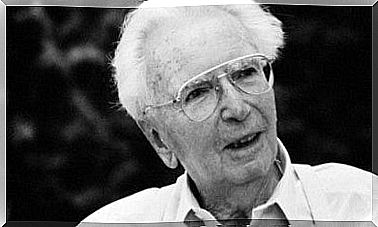Affective Flattening: Indifferent To Emotions

How would you feel if you were unable to express or experience emotions, or if you were suffering from affective flattening? Imagine for a moment that a relative of yours tells you that he has won the lottery and that you cannot rejoice for him. Remain impassive, don’t smile, don’t compliment yourself, your face is flawless. Cognitively, you are happy for him, but you don’t really feel that cheerfulness.
Let’s imagine that a person is fired for a totally unfair reason. This person, instead of feeling anger or sadness, is unable to express himself in any way. Affective flattening is a phenomenon that some people experience when they are unable to feel or express happiness, sadness, fear, anger or any other emotion when these are legitimate. The situations described reflect this phenomenon.
Before continuing to talk about affective flattening, let’s find out what emotions are and what role they play in our life. Only in this way will we be able to understand how affective flattening can have consequences on a person’s life.

What are emotions and what are they for?
Emotions are reactions that we all experience: joy, sadness, fear, anger … Although they are well known to most, if analyzed in depth and individually they can prove to be complex. Although we have all experienced anxiety or nervousness, not all of us are aware of the fact that mismanagement of these emotions can lead to blockages or even illness.
To simplify, emotions are the biological tendency of man to react in a certain way to certain stimuli. This tendency is innate in us and shapes itself with learning and the environment in which we grow up. Nowadays, most experts believe that different responses are related to emotions.
These responses or manifestations are as follows: first, a neurophysiological response is produced (caused by hormones and neurotransmitters) which manifests itself through another behavioral (such as gestures) and a cognitive one, that is, the one that allows us to become aware of that that we are trying. The latter two vary according to each individual’s environment and culture.
The hedonic tone of emotion, or the pleasant or unpleasant sensation or pleasure we experience, is the “spice of life”. Since the memories we hold are mainly related to emotions, the hedonic tone is fundamental for memory, for deciding, for forming our judgments and reasoning, for our behavior, our social relationships and our well-being.
Emotional tension is also crucial for making decisions. In fact, we often make our choices instinctively. However, the most important aspect of emotions is that they guide and motivate us.
Emotions are made up of two elements: on the one hand, the subjective sensation we feel inside us. On the other hand, the external manifestation of emotion. Sometimes the two components can be separated. For example, an actor can simulate all the manifestations of an emotion without actually feeling them.
What are emotions for?
One of the most important functions of emotions is to prepare us for action. They set in motion the energy necessary to give an effective response according to the circumstances, directing our conduct towards the desired goal. Each of the emotions points us and pushes us towards a different kind of action.

Emotions also fulfill a social function. Communicating our state of mind to the people around us facilitates and strengthens relationships with them. Our emotions act for others as signals: they suggest to them how to relate to us in the most appropriate way.
Finally, emotions also perform a motivational function. On the one hand, emotion sets motivated behavior in motion. Fright, for example, facilitates defensive reactions, happiness favors interpersonal attraction, surprise generates attention to new stimuli, and so on.
Emotions also direct our behavior, making it easier for us to reach or distance ourselves from the goal of motivated behavior according to how we feel. It is therefore clear how important it is to feel and express emotions.
Affective flattening: what is it all about?
Affective flattening is not a pathology. Rather, it is a symptom that alerts us to a problem. It could be defined as a symptom linked to the lack of expression and experimentation of emotions. Often this phenomenon is also referred to as emotional indifference or emotional numbness. The person who suffers from it, in fact, shows himself indifferent to the emotions of others and even to his own.
It must be emphasized that the absence of emotions occurs both on the level of positive and negative sensations. People are not incapable of experiencing only happiness, not even fear, for example. It is very rare that the affective flattening occurs with total intensity. In fact, those who suffer from it can experience emotions with different degrees of intensity, even if only in exceptional situations. It is more about the tendency to experiment with a general emotional tone while admitting very few variations.
Affective flattening and depression
People who exhibit emotional flattening are not necessarily depressed. Depression is associated with apathy and a low mood. In this sense, affective flattening should not be confused with the inability to experience pleasure.
The latter, defined in psychological terms as anhedonia, is typical of depressive disorders. People who are depressed no longer enjoy activities that previously enjoyed them. As a result, he stops realizing them and precludes himself from feeling better.
People with affective flattening experience emotions in a little intense, very light way, or do not experience them at all. However, unlike depressed people, they don’t feel bad about it. They feel nothing, but they don’t suffer from it.
Sometimes it is not easy to distinguish anhedonia from affective flattening, but it is also good to point out that they can occur simultaneously in the same person. To distinguish the two symptoms, remember that anhedonia is the inability to feel pleasure (a positive emotion). The affective flattening is, on the other hand, the absence of any emotion or a reduced expression of the same.
Affective flattening: why does it occur?
Affective flattening is the symptom or expression of an underlying pathology, as already mentioned. Therefore, it never manifests itself on its own. Affective flattening appears along with other symptoms, delineating a disorder or syndrome.
Affective flattening has always been associated with schizophrenia. Among schizophrenic disorders it is possible to distinguish two different types of symptoms: those with positive symptoms and those with negative symptoms.
Positive symptoms are those that involve an excess of people who do not have them. Conversely, negative symptoms manifest themselves as deficiency. For example, a hallucination would be an “excess” of perception, while apathy a “lack” of motivation.
Well, affective flattening falls into the group of negative symptoms of schizophrenia. But it is not only in schizophrenia that it can occur, but also in the case of autism spectrum disorders, for example. Autistic people experience difficulties in experiencing emotions intensely as well as expressing them correctly.
Affective flattening can also occur in cases of dementia, as a consequence of the changes that occur in the brain. As we have seen, affective flattening is part of a larger group of symptoms. To treat it, therefore, it is necessary to treat the underlying disease or disorder.









